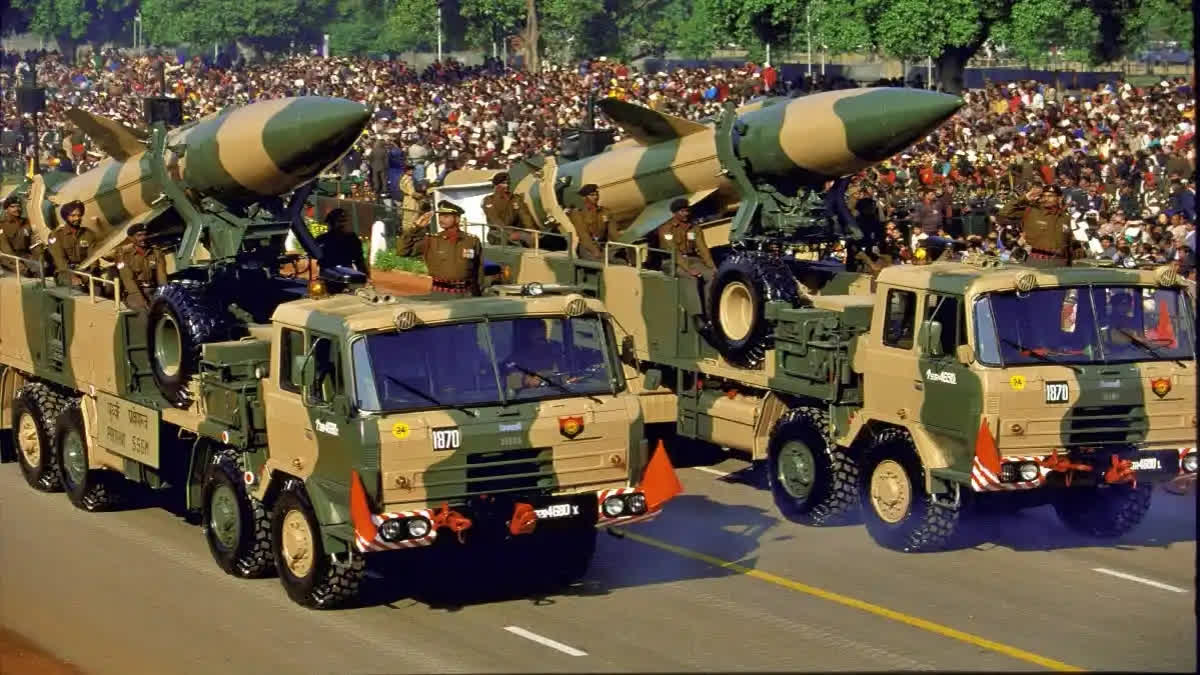New Delhi: Despite the speedy gains made by the Central government over the last few years on the atmanirbharta’ or self-reliance efforts to indigenise its military equipment, a recent report from Stockholm International Peace Research Institute (SIPRI) released on Monday said that India remains the world’s top arms importer.
According to the Swedish think tank SIPRI, India's "arms imports increased by 4.7 per cent between 2014–18 and 2019–23. Although Russia remained India’s main arms supplier (accounting for 36 per cent of its arms imports), this was the first five-year period since 1960–64 when deliveries from Russia (or the Soviet Union prior to 1991) made up less than half of India’s arms imports."
This report highlights the challenges of the prospect of two-front war faced by India at its border with China and Pakistan. Similarly, another crucial aspect highlighted by the SIPRI report is the fact that Russia made up for 36 per cent of India’s buys—the first five-year period ever since 1960–64 that it made up less than half of India’s arms imports.
Despite this, Russia (which invaded Ukraine back in February 2022 and is facing it's biggest challenge since the breakaway of Soviet Union) remains one of the top sources for weapons for India.
It is pertinent to note here that last year in October, CDS Anil Chauhan had said that "despite being a major nuclear power, the geopolitical importance of Russia will go down in times to come" while "we'll see a more assertive China in the time sti come."
The latest report thus indicates the efforts taken by India to wean away from its over-dependence of Russian arms as it continues to remain engaged in its war with Ukraine.
India's hostile neighbours, Pakistan and China who enjoys an iron-clan friendship as recently described by the China's President Xi Jinping while congratulating the newly Pakistani President remains a top ally in term of defence as well.
"Pakistan also significantly increased its arms imports (+43 per cent). Pakistan was the fifth largest arms importer in 2019–23 and China became even more dominant as its main supplier, providing 82 per cent of its arms imports", the report said.
Arms imports by two of China's East Asian neighbours increased, Japan's by 155% and South Korea's by 6.5%, it said. China's own arms imports shrank by 44%, mainly as a result of substituting imported arms -- most of which came from Russia, with locally produced systems.
"There is little doubt that the sustained high levels of arms imports by Japan and other US allies and partners in Asia and Oceania are largely driven by one key factor: concern over China's ambitions," said Siemon Wezeman, Senior Researcher with the SIPRI Arms Transfers Programme.
"The US, which shares their perception of a Chinese threat, is a growing supplier to the region," it said. Thirty per cent of international arms transfers went to the Middle East in 2019–23.
Three Middle Eastern states were among the top 10 importers in 2019–23: Saudi Arabia, Qatar and Egypt. Faced by the economic and Military advancements of China, the United States weapon sales “grew by 17 per cent between 2014–18 and 2019–23” while its “share of total global arms exports rose from 34 per cent to 42 per cent”.
France’s arms exports increased by 47 per cent between 2014–18 and 2019–23 and for the first time it was the second biggest arms exporter, just ahead of Russia.
Similarly, Europe which is witnessing a major geopolitical turmoil since the invasion of Ukraine by Russia which has set off alarm bells for the European Union to increase their defence budgets is also largely dependent on arms from the United States.
"Around 55 per cent of arms imports by European states in 2019–23 were supplied by the USA, up from 35 per cent in 2014–18. ‘More than half of arms imports by European states come from the USA,’ noted SIPRI Director Dan Smith, ‘while at the same time, Europe is responsible for about a third of global arms exports, including large volumes going outside the region, reflecting Europe’s strong military–industrial capacity", the report said.
Read more



